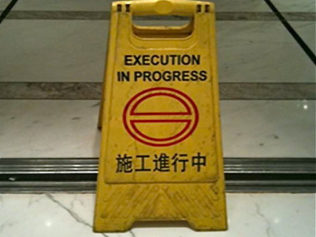The problem with perpetual infallibility: how to get good translations done fast

It is well known that the customer is always right but being right all the time can put you in a tough spot. When an attorney suggests a due date for a translation, service providers are unlikely to object or to question the decision-making process. This well-intentioned practice leaves some difficult decisions up to the law firm placing the order, without always providing them with the information necessary for good decision making.
Speed limits
Almost any turnaround request can be accommodated but, before making the request, it pays to think about how those accommodations will be made. Most technical translators can produce in the ballpark of three thousand words of polished product per day. (Three kilowords covers most mechanical patents, office actions, and licencing agreements, for example.) This limit can be stretched by a trick well-known to attorneys and their staff: working late into the night and early in the morning. But no amount of heroism will get you much above five thousand words a day. (The 5K mark is typically passed by pharmaceutical patents, briefs, and court decisions.) A twenty-thousand-word document, for example, can only be returned in two days if it is divided among multiple translators. Having four or five people working as fast as they possibly can on different parts of a long document has implications in terms of both overall understanding and consistency.
The space before and after
While a good translator with an empty desk should have no difficulty in clearing three thousand words between nine and five, the best translators rarely have an empty desk. This means that, at many translation agencies, jobs with short deadlines are more likely to be done by less-experienced or lower-ranked translators, who were twiddling their thumbs before the order came in. Also, keep in mind that one nearly-universal habit of highly-successful translators is that of reviewing their own work after a suitable “cool-down” period. As most attorneys know from experience, it is easier to spot problems and oversights in a document a day or two after the first draft has been penned. Best practice also calls for a second set of eyes to review the first translator’s work. Overly exacting deadlines can mean that these steps are foregone.
Get priority working for you
The whole point of using a translation agency rather than finding your own individual translators is to get the right resources working on your project without you having to manage every step. For cases involving multiple documents, numerous translators, reviewers, layout artists, and project managers can work in parallel, producing tens of thousands of polished words per day, without breaking the speed limits mentioned above. Although the minutiae of scheduling can be left to the people you are paying to worry about those things, it’s important to give them the input they need to optimize the process.
While an obvious starting point is to let the agency know which documents you want back first, care should be taken at this juncture. The problem is that attorneys often, and understandably, want to see the most important translations first. But if you simply say, “We need these three by Tuesday and we are not in a rush for the others,” you run the risk of having those three critically important documents translated by the people with nothing on their desks — the aforementioned thumb twiddlers — while the agency’s best talent is scheduled to take care of the boring documents that you were only translating out of an abundance of caution.
Unsurprisingly, good communication is the key. Don’t limit yourself to dates. Let the agency know what is important to you and why. If your agency knows that Document 1 is the disclosure that your whole case rests on, they are more likely to juggle workloads so that it can be handled by their top-gun translator. That could entail waiting an extra day on your part so, once again, talking it through will be a good idea.
When you are in a rush, another good trick is to ask your provider for an interim delivery of a first draft. That will get you a good understanding of what is disclosed in the shortest possible time, while allowing the translator (and hopefully a separate reviewer) to give the project the maximum amount of attention before finalizing the document that you will rely on.
To recap: build in enough time to allow the best work to be done; let the service provider know which documents to prioritize and why; and insist on good two-way communication to find the most expedient and effective schedule.




